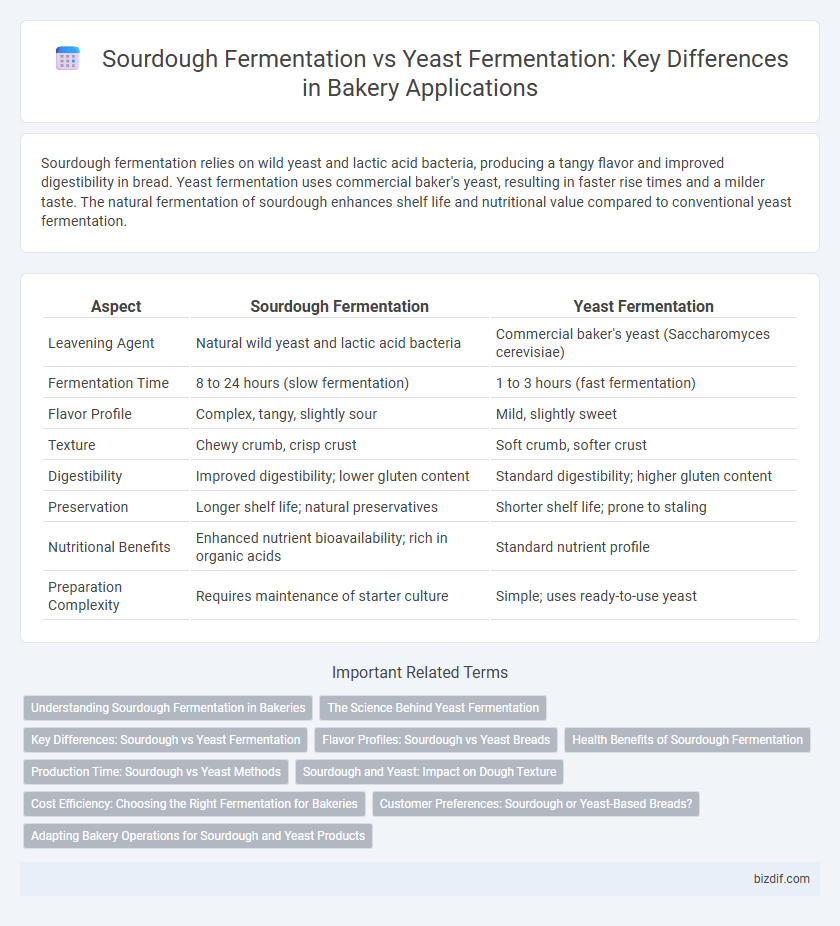Sourdough fermentation relies on wild yeast and lactic acid bacteria, producing a tangy flavor and improved digestibility in bread. Yeast fermentation uses commercial baker's yeast, resulting in faster rise times and a milder taste. The natural fermentation of sourdough enhances shelf life and nutritional value compared to conventional yeast fermentation.
Table of Comparison
| Aspect | Sourdough Fermentation | Yeast Fermentation |
|---|---|---|
| Leavening Agent | Natural wild yeast and lactic acid bacteria | Commercial baker's yeast (Saccharomyces cerevisiae) |
| Fermentation Time | 8 to 24 hours (slow fermentation) | 1 to 3 hours (fast fermentation) |
| Flavor Profile | Complex, tangy, slightly sour | Mild, slightly sweet |
| Texture | Chewy crumb, crisp crust | Soft crumb, softer crust |
| Digestibility | Improved digestibility; lower gluten content | Standard digestibility; higher gluten content |
| Preservation | Longer shelf life; natural preservatives | Shorter shelf life; prone to staling |
| Nutritional Benefits | Enhanced nutrient bioavailability; rich in organic acids | Standard nutrient profile |
| Preparation Complexity | Requires maintenance of starter culture | Simple; uses ready-to-use yeast |
Understanding Sourdough Fermentation in Bakeries
Sourdough fermentation relies on a natural symbiotic culture of wild yeast and lactic acid bacteria, creating complex flavors and increased shelf life compared to commercial yeast fermentation. This process involves longer fermentation times that enhance dough acidity, improving texture and crust development in bakery products. Bakers prioritize sourdough fermentation for its ability to produce artisanal breads with distinct taste profiles and better nutritional properties.
The Science Behind Yeast Fermentation
Yeast fermentation is a biological process where Saccharomyces cerevisiae converts sugars into carbon dioxide and alcohol, producing the gas that leavens dough. This process involves glycolysis, where glucose breaks down into pyruvate, generating energy and fermentation byproducts essential for dough rising and flavor development. Enzymes like invertase facilitate sugar breakdown, optimizing yeast metabolism for consistent bread texture and volume.
Key Differences: Sourdough vs Yeast Fermentation
Sourdough fermentation relies on wild yeast and lactic acid bacteria, producing complex flavors and a tangy aroma, while yeast fermentation uses cultivated baker's yeast for a quicker rise and milder taste. The natural fermentation process in sourdough enhances digestibility and shelf life due to organic acid production, contrasting with yeast fermentation's faster carbon dioxide release for rapid dough expansion. Temperature and fermentation time are crucial variables, with sourdough requiring longer, cooler proofing to develop its characteristic texture and flavor compared to the faster, warmer conditions optimal for yeast.
Flavor Profiles: Sourdough vs Yeast Breads
Sourdough fermentation produces complex flavor profiles with tangy, mildly acidic notes due to the natural wild yeast and lactic acid bacteria interaction, enhancing the bread's depth and character. Yeast fermentation leads to a cleaner, more consistent taste that is often sweeter and less complex, resulting from cultivated baker's yeast rapidly converting sugars into carbon dioxide and alcohol. The distinct sourness and aromatic richness of sourdough bread contrast with the mild and neutral flavor found in standard yeast-leavened breads.
Health Benefits of Sourdough Fermentation
Sourdough fermentation enhances the bioavailability of nutrients by breaking down phytic acid, which improves mineral absorption such as iron and zinc. The natural lactic acid bacteria in sourdough contribute to gut health by promoting beneficial microbiota and reducing inflammation. Unlike commercial yeast fermentation, sourdough fermentation lowers glycemic response, making it a healthier choice for blood sugar management.
Production Time: Sourdough vs Yeast Methods
Sourdough fermentation requires a longer production time, often ranging from 12 to 48 hours, due to the slow activity of wild yeast and lactic acid bacteria, which contribute to a complex flavor profile and improved texture. Yeast fermentation is faster, typically taking 1 to 3 hours, as commercial baker's yeast rapidly converts sugars into carbon dioxide, resulting in quicker dough rise and shorter production cycles. The extended fermentation time in sourdough enhances digestibility and shelf life, whereas yeast fermentation prioritizes speed and efficiency in bakeries.
Sourdough and Yeast: Impact on Dough Texture
Sourdough fermentation creates a denser, chewier dough texture due to the presence of lactic acid bacteria that produce organic acids, enhancing gluten development and dough elasticity. Yeast fermentation generates a lighter, airier texture as Saccharomyces cerevisiae metabolizes sugars, releasing carbon dioxide that forms gas bubbles and expands the dough. The interplay between the slower, acid-driven sourdough process and the faster, gas-producing yeast activity significantly influences the crumb structure and mouthfeel of baked bread.
Cost Efficiency: Choosing the Right Fermentation for Bakeries
Sourdough fermentation requires longer fermentation times and a consistent starter maintenance, which can increase labor costs but reduces dependency on commercial yeast purchases, offering potential savings in ingredient expenses. Yeast fermentation provides faster dough rise and predictable results, optimizing production schedules and reducing energy costs associated with extended proofing times. Bakeries must balance the higher time investment and labor of sourdough with the cost savings from natural fermentation, while yeast fermentation minimizes time and labor but involves ongoing yeast procurement expenses.
Customer Preferences: Sourdough or Yeast-Based Breads?
Sourdough fermentation produces complex flavors and a tangy aroma due to natural wild yeast and lactic acid bacteria, appealing to customers seeking artisanal and health-conscious bread options. Yeast fermentation delivers a softer texture and quicker rise, favored by those prioritizing convenience and a milder taste. Consumer preferences often depend on taste, texture, digestion benefits, and cultural familiarity with traditional or modern baking methods.
Adapting Bakery Operations for Sourdough and Yeast Products
Sourdough fermentation requires longer proofing times and precise temperature control to develop its characteristic tangy flavor and chewy texture, demanding adjustments in bakery scheduling and equipment. Yeast fermentation offers faster rise times, enabling higher throughput and more predictable consistency, benefiting large-scale production. Optimizing bakery operations involves balancing these techniques by allocating dedicated fermentation spaces and tailoring mixing, proofing, and baking processes to maintain product quality and meet diverse consumer preferences.
Sourdough fermentation vs Yeast fermentation Infographic

 bizdif.com
bizdif.com